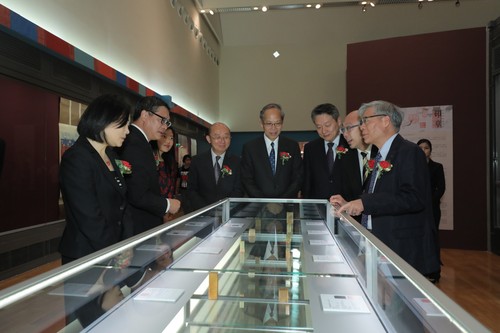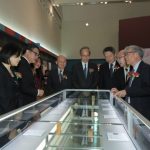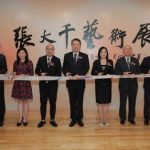 Guests visited the exhibiton.
Guests visited the exhibiton.
Jointly organised by the Macao Museum of Art (MAM, from the Portuguese acronym) of the Cultural Affairs Bureau and the Sichuan Museum, the exhibition “The Art of Zhang Daqian” features 100 masterpieces from the artist’s early and prime years collected by the Sichuan Museum, including his replicas of Dunhuang’s murals, landscape paintings, portraits, line drawings, letters and seals made and used by the artist before and after his stay in Dunhuang. Through these valuable works, the audience can deepen their knowledge on the artistic career and creativity of Zhang Daqian. This exhibition, integrated in the 28th Macao Arts Festival, was inaugurated on Tuesday, 23 May, at 6:30pm, on the 4th floor of the MAM. The opening ceremony was officiated by the Assistant of the Deputy Director of the Department of Education and Culture of the Liaison Office of the Central People's Government in the Macao S.A.R., Shao Bin; the Vice President of the Cultural Affairs Bureau of the Macao S.A.R. Government, Kent Ieong Chi Kin; the Representative and Director of the Museum Division of the Culture Heritage Administration of Sichuan Province, Lily Li Bei; the Acting Director of the Macao Government Tourism Office of the Macao S.A.R. Government, Tse Heng Sai; the Director of Macao Daily News, Lok Po; the President of the Chinese Cultural Exchange Association, Lei Pui Lam; the Executive Vice President of the Yu Un Painting & Chinese Calligraphy Association, Sio Chun Iun; the President of the Macau Artist Society, Lai Ieng; and the Director of the Macao Museum of Art of the Cultural Affairs Bureau of the Macao S.A.R. Government, Chan Kai Chon.
Zhang Daqian (1899-1983) is one of the most respected masters of Chinese painting of the 20th century. He was well versed in poetry, calligraphy, painting and engraving, marking the history of contemporary painting. Hailed as “one of the great painters of the last 500 years” by Xu Beihong, the artist, however, believed painting was basically “70% effort and 30% talent”. In his early years, Zhang Daqian focused on ink wash painting from the Ming and Qing dynasties but, in 1926, he left on a tour to cross famous mountains and rivers and learned from Nature. In order to explore the artistic roots of Chinese painting, he examined and emulated the ancient murals in Dunhuang – the Pearl of the “Silk Road” – for more than two years since 1941. His replicas in this period reveal an important shift towards a style heavy in colours and are a milestone in the artist’s career. Later, he developed a splash ink style during his travel to Dunhuang. After his travel to Dunhuang, his portraits of female figures shifted from a delicate aesthetics to a plump gracefulness.
This exhibition allows the public to appreciate Zhang Daqian’s artistic vision through his ancient works in the early years, the grand and extraordinary replicas of Dunhuang’s murals in his middle period, his later shift to an interpretation of female beauty and the seals he used. The exhibition provides a rare opportunity to understand comprehensively Zhang Daqian’s historical path before his recognition. In 1949, Zhang Daqian resided in Macao where he created some of his works. Decades later, his works are shown the city thereby giving a special meaning to this exhibition, not to be missed.
The exhibition “The Art of Zhang Daqian” is open until 6 August 2017 at the MAM, located on Avenida Xian Xing Hai, NAPE, Macau. Admission is free and the museum is open daily from 10am to 7pm, including on public holidays (no admission after 6:30pm; closed on Mondays). For more information, please visit the MAM’s webpage at www.MAM.gov.mo. For enquiries, please contact MAM through tel. no. 8791 9814, during office hours.
View gallery


